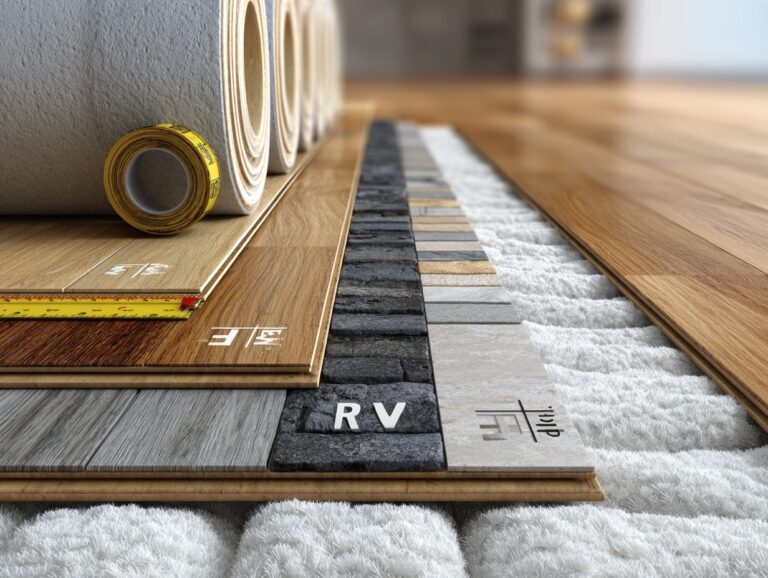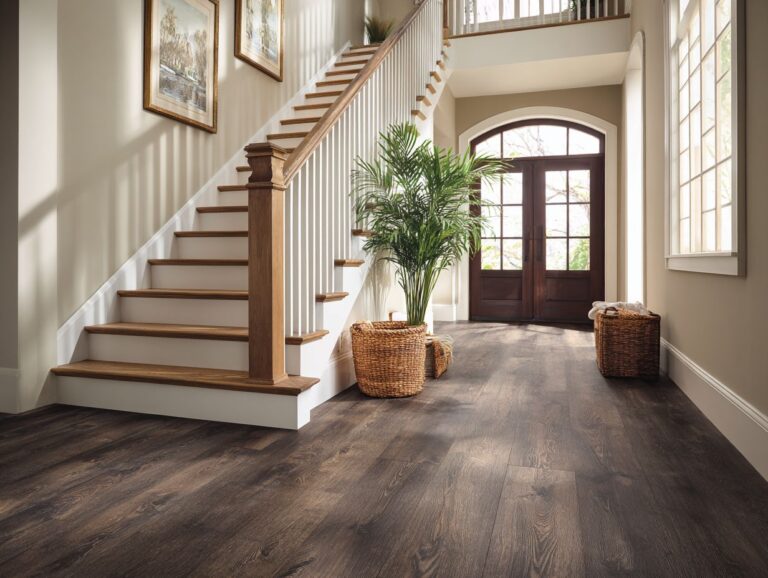Heated Tile Flooring Systems – Electric vs Hydronic
Contents
- Introduction to Heated Tile Flooring Systems
- Heated Tile Flooring Market Statistics
- Types of Heated Tile Flooring Systems
- Electric Heated Flooring
- Hydronic Heated Flooring
- Comparative Analysis
- Frequently Asked Questions
- 1. What is the difference between electric and hydronic heated tile flooring systems?
- 2. Which type of heated tile flooring system is more energy efficient?
- 3. Are there any safety concerns with electric heated tile flooring systems?
- 4. Can both electric and hydronic heated tile flooring systems be used with any type of tile?
- 5. Which type of heated tile flooring system is easier to install?
- 6. Can I control the temperature of my heated tile flooring system?
Introduction to Heated Tile Flooring Systems
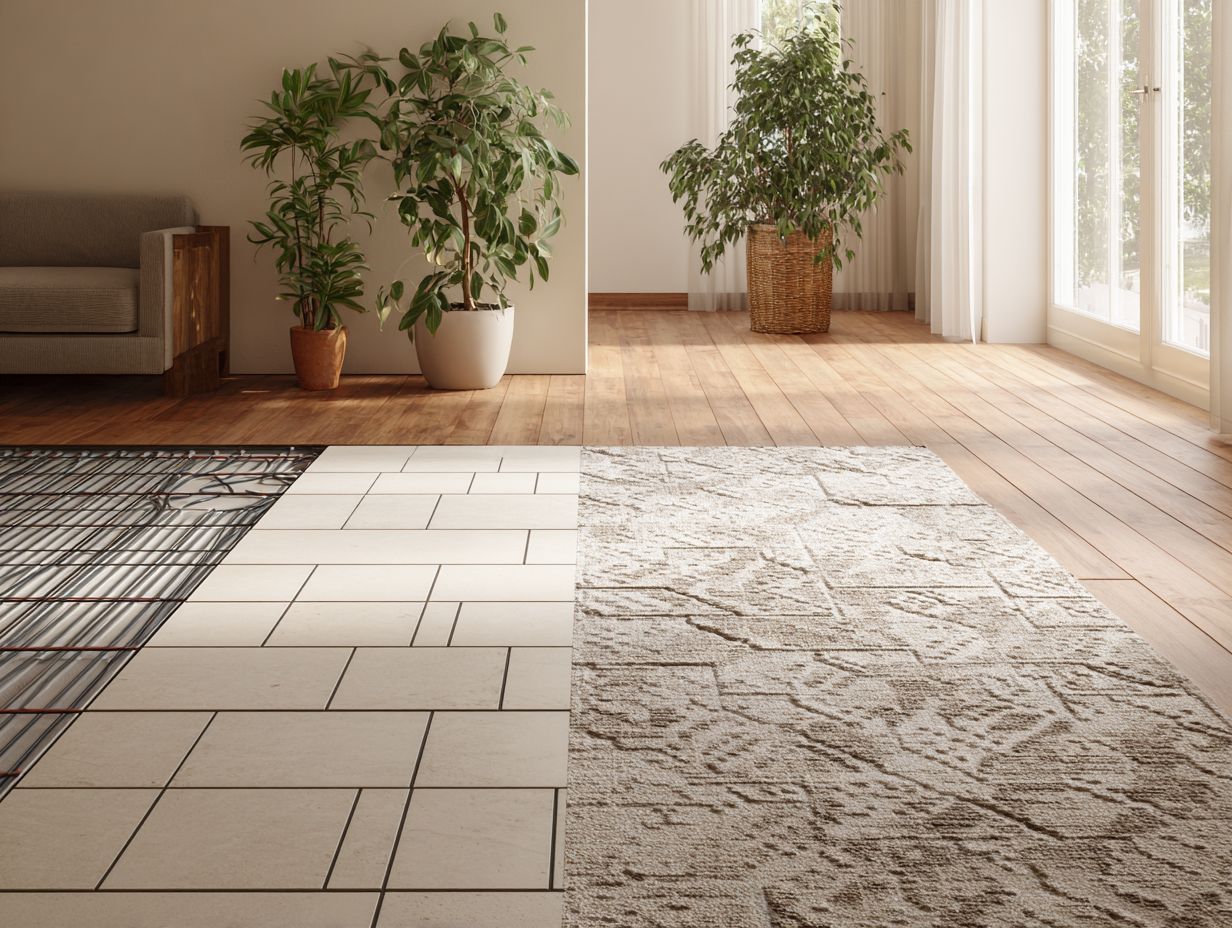
Key Takeaways:
Definition and Overview
Heated flooring, also known as radiant heating, is a system that delivers warmth directly through the floor, achieving even heat distribution and improved comfort levels.
This system operates by using either electric cables or water-filled tubing beneath the floor surface, with the former providing quicker heat while the latter tends to be more energy-efficient.
In today’s home updates, heated floors are becoming more popular because they make homes more comfortable and can increase property value.
For installation, homeowners often choose between two types:
- Radiant floor heating mats, ideal for DIY projects
- Hydronic systems, which are better suited for new constructions due to their complexity
Each choice requires careful consideration of the space and budget.
Heated Tile Flooring Market Statistics
Heated Tile Flooring Market Statistics
Choosing the right tile is crucial for both design aesthetics and durability in your flooring project. If you’re considering different options, our comparative analysis on porcelain vs ceramic tiles might be of interest, especially in terms of composition, cost, and durability.
Market Growth and Segmentation: Global Market
Market Growth and Segmentation: North America Market
The Heated Tile Flooring Market Statistics gives useful information about market growth and segmentation patterns, concentrating on global and North American markets. The data shows more people are choosing heated tile flooring because they want better comfort and heating that saves energy.
Market Growth and Segmentation data reveals significant growth prospects. Globally, the heated tile flooring market is expected to grow at a compound annual growth rate (CAGR) of 6.4% from 2023 to 2030. This growth is indicative of rising consumer interest in home improvement products that offer both comfort and sustainability. In 2022, the market was valued at $4.51 billion supporting the strong current demand Notably, the residential sector accounts for 48.3% of the market share, highlighting its dominant role. Homeowners are increasingly investing in heated flooring solutions for bathrooms, kitchens, and living spaces, driven by the benefits of consistent, efficient heating.
In the North American market, the 2023 market value is estimated at $2.1 billion, with projections suggesting it will reach $3.5 billion by 2033. This represents a CAGR of 5.24% over the decade. This growth is supported by a greater emphasis on energy-saving methods and the use of advanced home technologies. The North American market benefits from consumer awareness and the presence of key industry players who drive innovation and accessibility.
Overall, these statistics show a strong demand trend for heated tile flooring, driven by people’s preference for up-to-date, cozy, and effective home heating options. Manufacturers and retailers can benefit from this growth by creating new products and aiming at the large residential sector market share. The North American market is growing steadily, offering a big chance for growth and investment in this fast-changing industry.
Importance of Heated Flooring
Heated flooring improves home comfort by maintaining a consistent temperature, making living areas more pleasant, especially during cold weather.
Beyond comfort, heated flooring can lead to notable energy savings, with studies indicating up to 25% reduction in heating costs. For instance, electric radiant floor heating systems provide even warmth that minimizes excess energy use.
Homeowners can choose between:
- Hydronic systems, which circulate hot water through pipes
- Electric setups that use heating cables
Putting in a programmable thermostat can make your heating and cooling more efficient by changing temperatures to fit your daily routine. This mix of comfort and effectiveness can improve the home setting and lower monthly energy costs.
Types of Heated Tile Flooring Systems
There are two primary types of heated tile flooring systems: electric and hydronic. Each has its own advantages and disadvantages suitable for various requirements.
Electric Heated Flooring
Electric heated flooring systems use electric cables or mats installed beneath the tile to provide radiated warmth directly to the floor surface.
These systems operate through resistive heating, where electric currents pass through the cables, generating heat.
There are multiple methods for installing:
- ‘Thin-set’ systems are laid directly under tile with thin mortar,
- while ‘encapsulated’ mats are embedded within a self-leveling compound.
You can set thermostatic controls to manage heat effectively and reduce power consumption. For example, the Nuheat system provides ready-to-use mats that are easy to install, while Honeywell’s thermostats allow for easy scheduling, letting you fully manage your home’s temperature.
Hydronic Heated Flooring
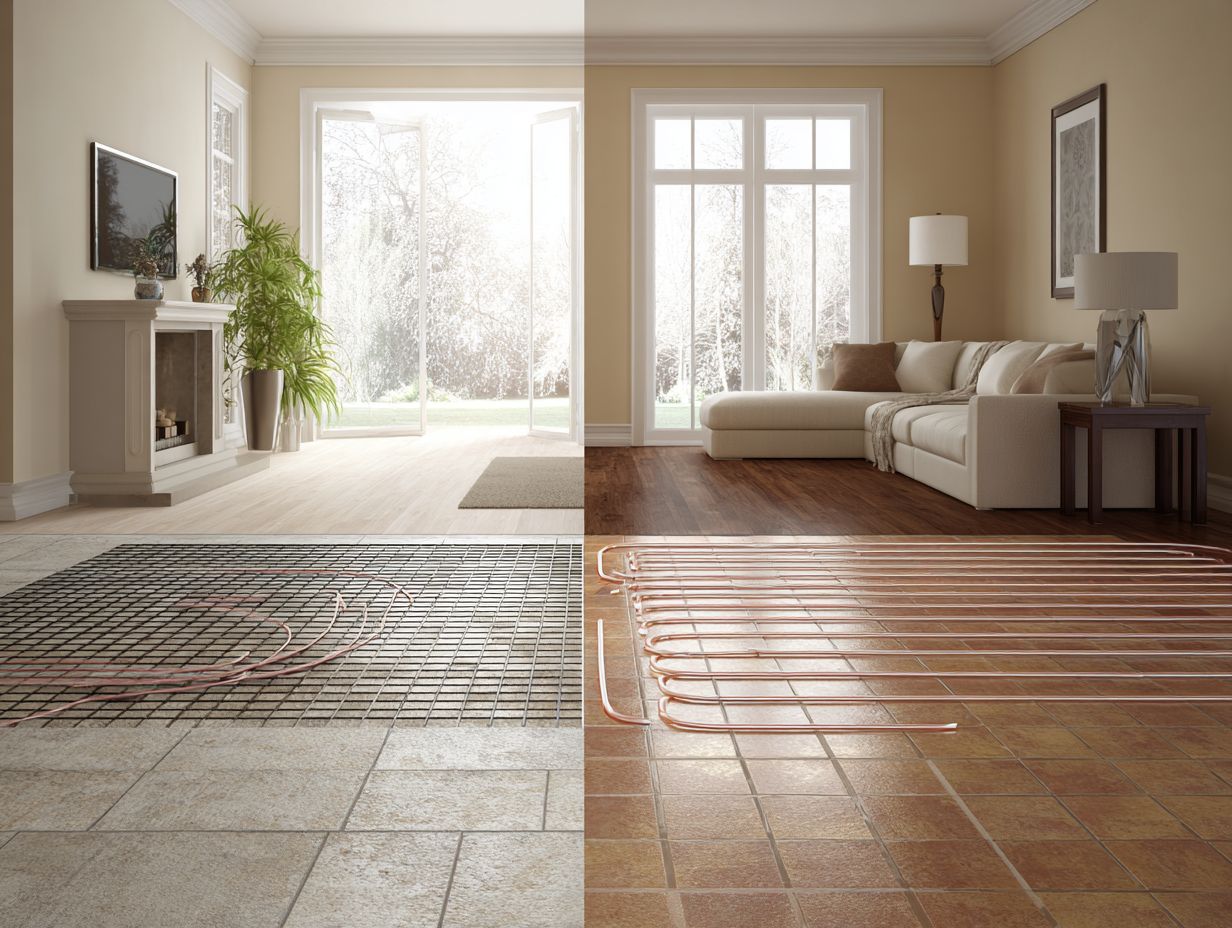
Hydronic heated flooring relies on circulating warm water through pipes installed beneath the floor, offering efficient heating for larger areas.
The system begins with a boiler, which heats the water and pumps it through the network of pipes. It’s important to select a boiler with the right size; for instance, a condensing boiler can make energy use better by using heat from the exhaust.
Thermal mass, usually in the form of concrete or tile, plays a significant role by absorbing and retaining heat. This enables a more stable temperature throughout the space, reducing energy consumption. Properly insulating the system improves how it works by reducing heat loss.
Electric Heated Flooring
Electric heated flooring systems are popular for their easy installation and quick warmth, but they can be expensive.
How Electric Systems Work
Electric systems use heating cables installed beneath the floor, which warm up the surface and control room temperatures well.
These cables link to a thermostat, letting you change the temperature to how you like it.
To set up, first, follow the manufacturer’s instructions for wiring. Make sure the circuit complies with local electrical regulations. A lot of systems use programmable thermostats like the Nest, which users can manage with smartphone apps. This manages heating schedules and provides features to save energy.
A floor sensor can make a room more comfortable by ensuring the heat spreads evenly, as it measures the actual floor temperature.
Installation Process
Installing electric heated flooring typically involves laying out heating cables, connecting them to a thermostat, and ensuring proper insulation for energy efficiency.
- First, start by measuring the installation area and choosing a heating cable system that fits your space, such as the Nuheat system, which is user-friendly.
- Next, lay out the cables according to your design, maintaining even spacing, typically around 3 inches apart.
- You’ll need to attach the cables to a thermostat that works with your heating system, such as the Honeywell RTH9585WF, which allows you to set schedules.
- Keep heat well contained below by using effective insulation, such as XPS foam boards.
- Completing this process usually takes 2-3 days depending on the complexity.
Cost Considerations
The initial cost for electric heated flooring installation can range from $6 to $12 per square foot, with ongoing energy costs varying based on usage.
For example, a 300-square-foot room could cost between $1,800 and $3,600 for installation, depending on the complexity and materials chosen.
Operational costs typically range from $0.12 to $0.25 per kilowatt-hour, meaning heating that room could add $30 to $50 to your monthly electricity bill during winter.
It’s essential to factor in insulation quality and local energy rates, as they greatly influence overall expenses. Purchasing a thermostat that adjusts to your routines can help you save energy, potentially lowering your bills.
Advantages of Electric Systems
Electric heated flooring systems warm up fast, are easy to set up, and let you control the temperature precisely. They work well for small spaces or when updating a room.
One major advantage is their energy efficiency, often reducing heating bills by up to 25%. For example, in a 300-square-foot bathroom, installing an electric system can warm the space in just 30 minutes, compared to traditional systems that may take hours.
Tools like the Nuheat Signature thermostat allow for granular temperature control, enabling users to schedule heating times easily. Setting it up is simple, so you typically don’t need professional help, making it a doable task for homeowners.
Disadvantages of Electric Systems
Despite their advantages, electric heated flooring systems can lead to higher operating costs and may not be cost-effective for large areas.
For instance, studies show that electric floor heating can add $300 to $500 annually to energy bills, especially in expansive spaces.
These systems often use more electricity than necessary, especially if you don’t check the thermostat settings regularly.
Homeowners can mitigate costs by using programmable thermostats, which allow for setting optimal heating times, or considering zone heating, where only specific areas are heated during peak use.
This method cuts energy use and lowers heating costs a lot.
Hydronic Heated Flooring
Hydronic heated flooring is popular because it saves energy and keeps temperatures steady, especially in big areas.
How Hydronic Systems Work
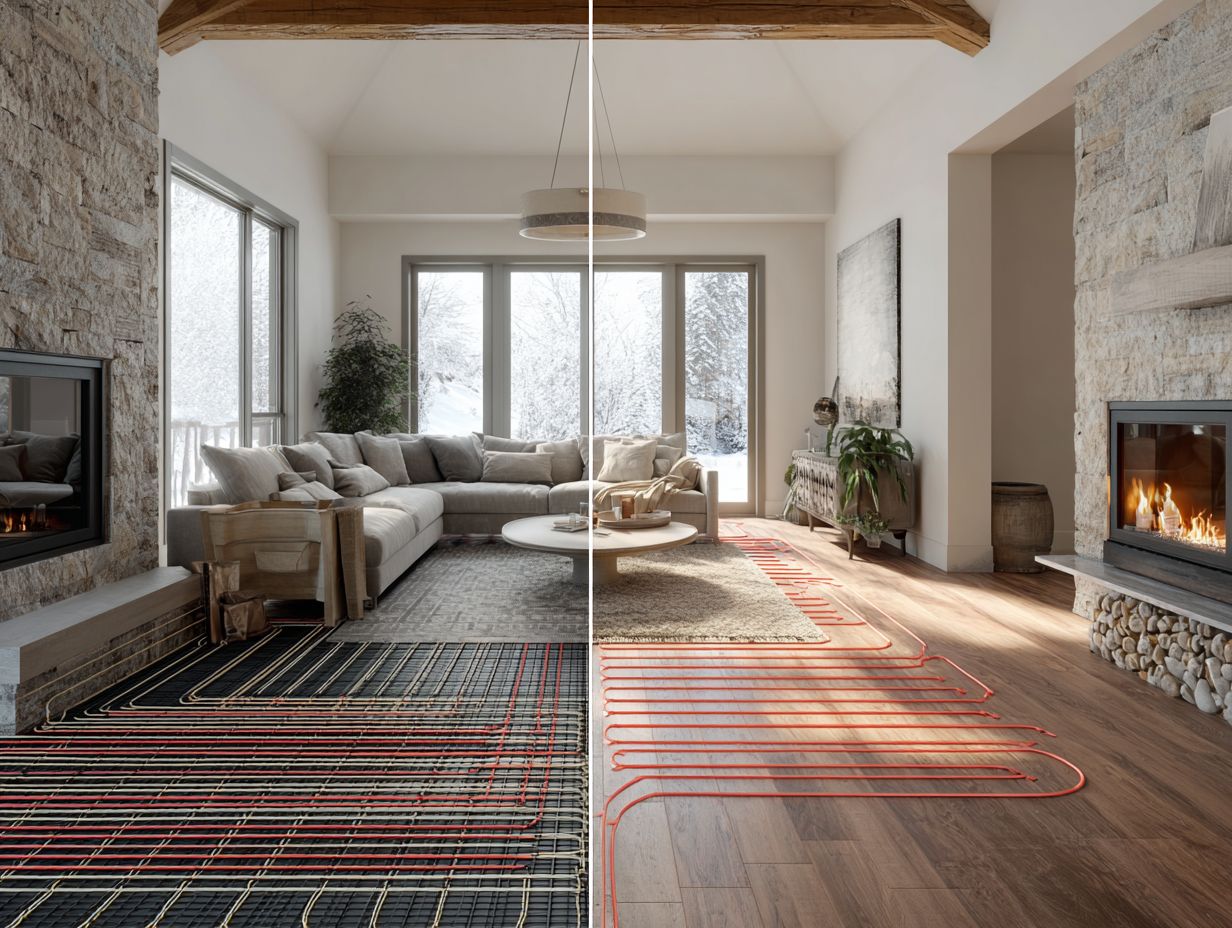
Hydronic systems use PEX tubing to move hot water, using thermal mass to store and distribute heat effectively.
The mechanism begins with a boiler or water heater, which heats the water before it’s pumped through the tubing.
As the hot water moves through the system, it transfers heat to the surrounding spaces, aided by the thermal mass of the floors or walls, which retain heat even after the water cools.
For optimal efficiency, consider integrating thermostats and zoning controls. These tools can help maintain desired temperatures in individual rooms, ensuring energy is used wisely while enhancing comfort throughout your living space.
Installation Process
The installation of hydronic heated flooring involves laying PEX tubing, connecting it to a boiler system, and ensuring proper insulation to maximize efficiency.
Start by gathering essential materials:
- PEX tubing
- A manifold
- A boiler
- Insulation boards
The installation process typically takes 3-5 days.
Begin by planning the layout of the tubing, ensuring even heat distribution. Lay the insulation boards down first to avoid heat loss, then carefully install the PEX tubing based on your layout.
Connect the tubing to the manifold and boiler, ensuring all connections are secure. A common challenge is preventing kinks in the tubing; use PEX supports to maintain proper spacing.
Pressure-test the system before covering it with flooring.
Cost Considerations
Hydronic heating systems generally have higher upfront costs, averaging between $10 to $20 per square foot, but can lead to lower long-term operating costs.
The installation of hydronic systems typically requires a professional plumber and may include extensive retrofitting, adding to the initial investment.
Many users find that this cost is offset by energy savings of up to 30% on heating bills over time, especially when connected to energy-efficient boilers. These systems can last 20 years or more with proper maintenance, enhancing their cost-effectiveness.
To save more energy, think about getting a programmable thermostat. It can change the temperature for you according to your daily routine.
Advantages of Hydronic Systems
Hydronic systems are very energy-efficient and offer high comfort by spreading heat evenly, which makes them perfect for big spaces.
These systems use water heated by a boiler to circulate warmth through pipes, ensuring consistent temperatures. In large homes, they outperform traditional electric heating by reducing energy costs and enhancing humidity control.
For example, a 3,000 sq. ft. home can save up to 30% on heating bills with hydronic heating. Using tools like Nest thermostats can help save energy, while zoning systems let you set different temperatures in various parts of your home for better comfort and control.
Disadvantages of Hydronic Systems
The challenging installation and upkeep of hydronic systems might put off some homeowners, even though these systems offer long-term advantages.
A big downside is the complicated installation, which usually needs a professional and can cost from $3,000 to $10,000 based on your home size and current setup.
Hydronic systems necessitate routine maintenance, like checking for leaks and ensuring proper water levels, possibly leading to annual costs of $200-$500.
These factors create a barrier for many, especially those looking for easier, less costly heating solutions. Homeowners should consider these challenges compared to the efficiency and comfort these systems provide in the end.
Comparative Analysis
When deciding between electric and hydronic heated flooring systems, it’s important to consider how well they work, how comfortable they are, and how easy they are to maintain.
Efficiency and Energy Consumption
Hydronic systems usually save energy because they cost less to run and can use different heat sources like heat pumps.
These systems can use solar power, geothermal setups, or even waste heat from factories.
For example, using a ground-source heat pump with a hydronic setup can lead to a reduction in energy consumption by up to 30% compared to traditional heating methods.
Homeowners can think about setting up programmable thermostats that adjust settings depending on whether people are home, to reduce energy use.
Regularly maintaining the system, like flushing the pipes and checking for leaks, can prevent performance dips, ensuring consistent energy savings throughout its lifespan.
Comfort and Heat Distribution
Both electric and hydronic systems offer excellent comfort, but hydronic systems tend to maintain a more stable ambient temperature over larger areas.
This stability is largely attributed to how hydronic systems distribute heat through water-filled pipes, resulting in even warmth across the room. In contrast, electric systems provide quicker heat but may create hot spots.
To improve comfort, try using programmable thermostats with hydronic systems. These help control heat more evenly and adjust to when they are used during different times of the day.
Regular maintenance, like flushing pipes and checking pressure, can improve how well the system works and lasts, keeping it running smoothly over time.
Maintenance Requirements
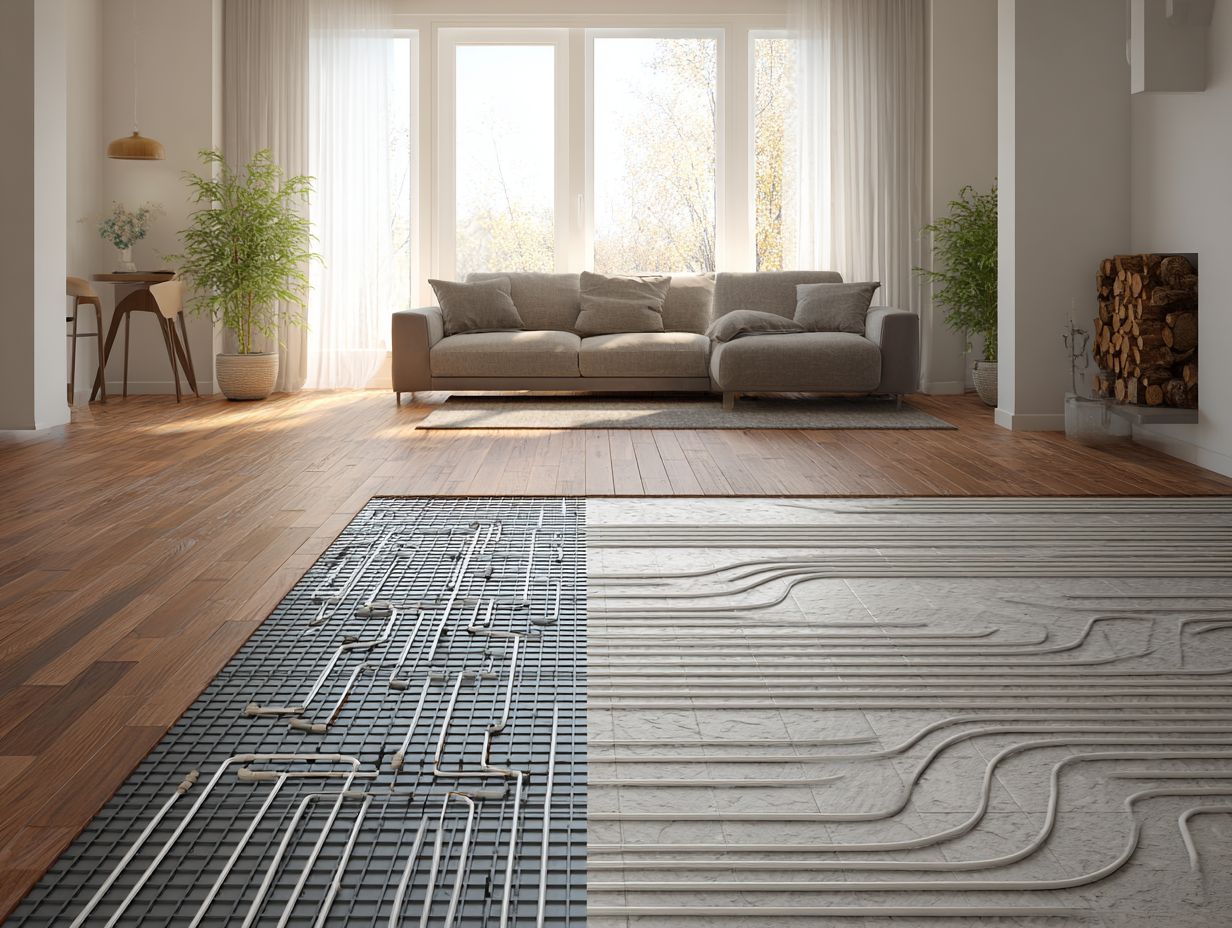
Electric systems require minimal maintenance due to fewer moving parts, while hydronic systems may necessitate regular checks of the pump and boiler.
To keep everything working well, check both systems every season.
Check the electric systems for worn wires and make sure the connections are tight. For hydronic systems, look at the pressure gauge every month and clean the water filter twice a year to prevent clogs.
Consider using a digital maintenance log app like HomeZada to monitor tasks and receive alerts about due dates. This helps maintain things regularly instead of waiting for them to break.
Suitability for Different Spaces
Electric heated flooring is ideal for small spaces and retrofits, whereas hydronic systems are more suited for larger areas or new builds.
For small bathrooms or kitchens, electric heated flooring can be installed quickly and often doesn’t require extensive renovations. Products such as the Schluter-DITRA-HEAT (around $5 per square foot) make it easy to install under tiles.
Conversely, hydronic systems, such as Uponor’s PEX tubing, are excellent for larger living areas, providing even heat distribution but requiring more complex installation and space for a boiler. This approach aligns with the principles outlined in our analysis of Porcelain vs Ceramic Tile – Composition, Cost & Durability.
Assess your project scope and budget to determine the best system, as the choice will influence energy efficiency and comfort in your home.
Final Thoughts on Choosing the Right System
In the end, choosing between electric and hydronic heated flooring should match your particular heating requirements, the design of your home, and your budget.
For instance, if you have a smaller area or prefer a quicker installation, electric flooring may be ideal.
Tools like the SunTouch WarmWire system can quickly heat areas and allow easy DIY installation for approximately $5-$8 per square foot.
On the other hand, hydronic systems, such as the Uponor PEX, are better suited for larger areas and long-term cost savings but require more complex installation, often ranging from $6-$12 per square foot.
Assess your priorities regarding cost, efficiency, and install complexity to make the best choice.
Frequently Asked Questions
1. What is the difference between electric and hydronic heated tile flooring systems?
Electric heated tile flooring systems use electric cables or mats installed beneath the tile to generate heat, while hydronic systems use hot water pipes installed beneath the tile.
2. Which type of heated tile flooring system is more energy efficient?
Hydronic systems are generally considered more energy efficient than electric systems, as they use hot water from a boiler instead of electricity.
3. Are there any safety concerns with electric heated tile flooring systems?
Electric heated tile flooring systems are generally considered safe, as they have built-in temperature controls and do not produce harmful emissions. However, make sure a professional installs them and follow the manufacturer’s instructions carefully.
4. Can both electric and hydronic heated tile flooring systems be used with any type of tile?
Yes, both types of systems can be used with any type of tile as long as they are installed properly and according to the manufacturer’s guidelines.
5. Which type of heated tile flooring system is easier to install?
Electric heated tile flooring systems are generally easier and less expensive to install, as they do not require a boiler or water pipes to be installed. However, how difficult it is to install can change based on the particular system and the size of the space to be heated.
6. Can I control the temperature of my heated tile flooring system?
Yes, both electric and hydronic systems usually have built-in temperature controls that allow you to adjust the heat output. Some systems also offer the option to program temperature settings for different times of day.
